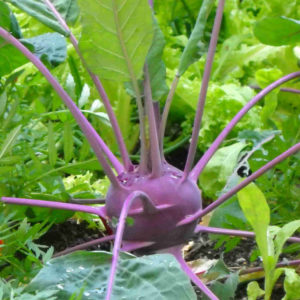What is it?
Kohlrabi is a member of the diverse brassica family (broccoli & cauliflower, collards and kale, cabbage and brussels sprouts, turnips and mustards). The name comes from combining the Germanic words for cabbage (kohl) and turnip (rübe), and hence is sometimes nick-named a German turnip. While it looks like a root vegetable, it’s really an enormous, bulbous stem. It grows above ground and leaves grow out of it. The leaves are edible too, so it’s a great two for one.
What does it taste like?
The flavor of kohlrabi is often compared to the flavor of broccoli stems. This makes sense, as broccoli is also a brassica, and it’s the brassica stem that most people are familiar with. I’ve tasted them side by side, and pretty much agree. If you blind tasted them, it would be hard to differentiate between broccoli stems and the kohlrabi bulb. But, by genus and species, kohlrabi is brassica oleracea, which is the same genus and species as cabbage! Yeah, kohlrabi is a headless cabbage. Kohlrabi is Brassica oleracea var. gongylodes and cabbage is brassica oleracea var. capitata. So, what kohlrabi really tastes like is the core of a cabbage. Most people discard the core of the cabbage, but it’s actually quite delicious. That will be a topic for another post.
Is the whole thing edible?
Mostly. The outer peel is quite tough, and the area at the bottom, right where the root was attached is woody. So, you’ll want to discard (preferably compost) those parts. But the bulb, stems and leaves are all edible. At the market you may find white, green or gorgeous purple kohlrabi. I’m usually all about pigment, and would seek out the purple variety. But it won’t matter much. The color is only skin deep. That’s the hardest part about working with kohlrabi, peeling the tough outer skin. Some people opt to carve it off using a chef’s knife. I find that to be quick, but I waste to much of the tender deliciousness under the skin. I use a knife to remove the bumps from which the leaf stems emerged, and then use a sturdy vegetable peeler like the one OXO makes. Some prefer the Y shaped version. Depending on how thick the skin is, it may take a second pass with the peeler around the bulb.
What can you do with it?
Kohlrabi is delicious raw or cooked.
One option for raw would be to slice it paper thin and dress it with a nice olive oil and a pinch of salt. Another option for raw would be to cut it into sticks and serve crudités style, maybe with some hummus as a dip. A third option for raw would be to put the whole thing into a slaw. Shred the bulb into toothpick sized matchsticks, julienne the leaves, and chop the stems, then toss with your favorite slaw dressing.
A great cooked option is to cut it into disks, toss them with some salt, pepper and olive oil, and throw them on the grill. You’ll get some sweet caramelization on the outside, and a moist tender inside. Same thing with roasting, but with roasting I’d cut into chunks instead of disks. Blanching in salty water or sautéing are equally viable options. It also works great in a Cream of Anything Soup.
Really, do anything with the bulb that you would do with broccoli stems and do anything with the leaves that you would do with kale. And the leaf stems are great too. They are surprisingly non-stringy so simply cleaning them up and serving as crudités is an option. Another option for the leaf stems would be to make a quick pickle. If nothing else, you can dice them up and cook with the aromatics of any dish that starts with a mirepoix or soffritto.

